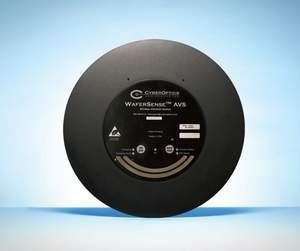Dec 4 2008
Process engineers convening at SEMICON Japan 2008 discussed the effects of equipment vibration and acceleration on wafer processing during demonstrations by a maker of wireless metrology devices for wafer processing equipment, CyberOptics Semiconductor, Inc., at booth 1A-403, Hall 1 at Makuhari Messe.
 Process engineers convening at SEMICON Japan 2008 discussed the effects of equipment vibration and acceleration on wafer processing during demonstrations by a maker of wireless metrology devices for wafer processing equipment, CyberOptics Semiconductor, Inc., at booth 1A-403, Hall 1 at Makuhari Messe.
Process engineers convening at SEMICON Japan 2008 discussed the effects of equipment vibration and acceleration on wafer processing during demonstrations by a maker of wireless metrology devices for wafer processing equipment, CyberOptics Semiconductor, Inc., at booth 1A-403, Hall 1 at Makuhari Messe.
Yukinobu Hayashi, an applications engineer for the company, said his team addressed how process engineers at both 300mm and 200mm fabs who employ the "best-known method" to measure the amplitude and frequency of equipment vibrations -- which entails listening for noises and visually monitoring wafer movements -- generally don't obtain the vibration data to improve processes.
Vibration data serves as a predictor of robot and transfer-equipment failures and an indicator of wafer particle-contamination sources and inefficient movement by cassettes, SMIFs and FOUPs, according to the company's CTO, Dennis J. Bonciolini.
Hayashi said engineers at SEMICON Japan from CyberOptics Semiconductor, a subsidiary of CyberOptics Corp. (NASDAQ: CYBE), demonstrated how process engineers use a wireless, wafer-like device to obtain real-time data on the amplitude and frequency of vibrations generated by process equipment and automated material handling systems.
"We know equipment vibration disrupts processes and productivity, but it's very hard -- if not impossible -- to trace and correct root causes manually," Hayashi said. "Of course, each disruption has a source and can be minimized or eliminated, but you need the local vibration data first."
Engineers at CyberOptics Semiconductor's booth demonstrated the company's WaferSense® Auto Vibration System (AVS) and its companion software. The team discussed how process engineers use data from the device to establish yield-based vibration standards for equipment and technicians, identify links between vibration frequency -- such as isolated shocks versus steady humming -- and likely sources and acceptable acceleration parameters for equipment.
Fabs use data obtained by the AVS to shorten equipment qualification times, lower maintenance expenses and optimize equipment productivity and yield, according to Hayashi.
CyberOptics Semiconductor also demonstrated its entire line of WaferSense products at SEMICON Japan, including its Auto Teaching System (ATS), Auto Leveling System (ALS2 V) and Auto Gapping System (AGS). Each device follows the processing life of a wafer and reports real-time metrology data.
The AVS -- and entire WaferSense line -- was developed by CyberOptics Semiconductor as part of its "heavy focus" on R&D to address metrology challenges in fabs, Hayashi said.
WaferSense AVS' key specifications and features include form factors of SEMI 200mm notch or flat and 300mm, range of +/-2G, resolution of +/-0.01G, operating pressure of 760 to less than 10 -6 Torr, operating temperature of 20 to 70 degrees Celsius, height of 6.3mm, weight of 150gm at 200mm and 190gm at 300mm (light), wireless Bluetooth link, four hour run-time per battery charge and use with Windows 2000, XP and Vista.
The WaferSense AVS package includes the vibration-sensing wafer, USB-compatible link, VibeView™ and VibeReview™ software CD, charging case and suitcase.